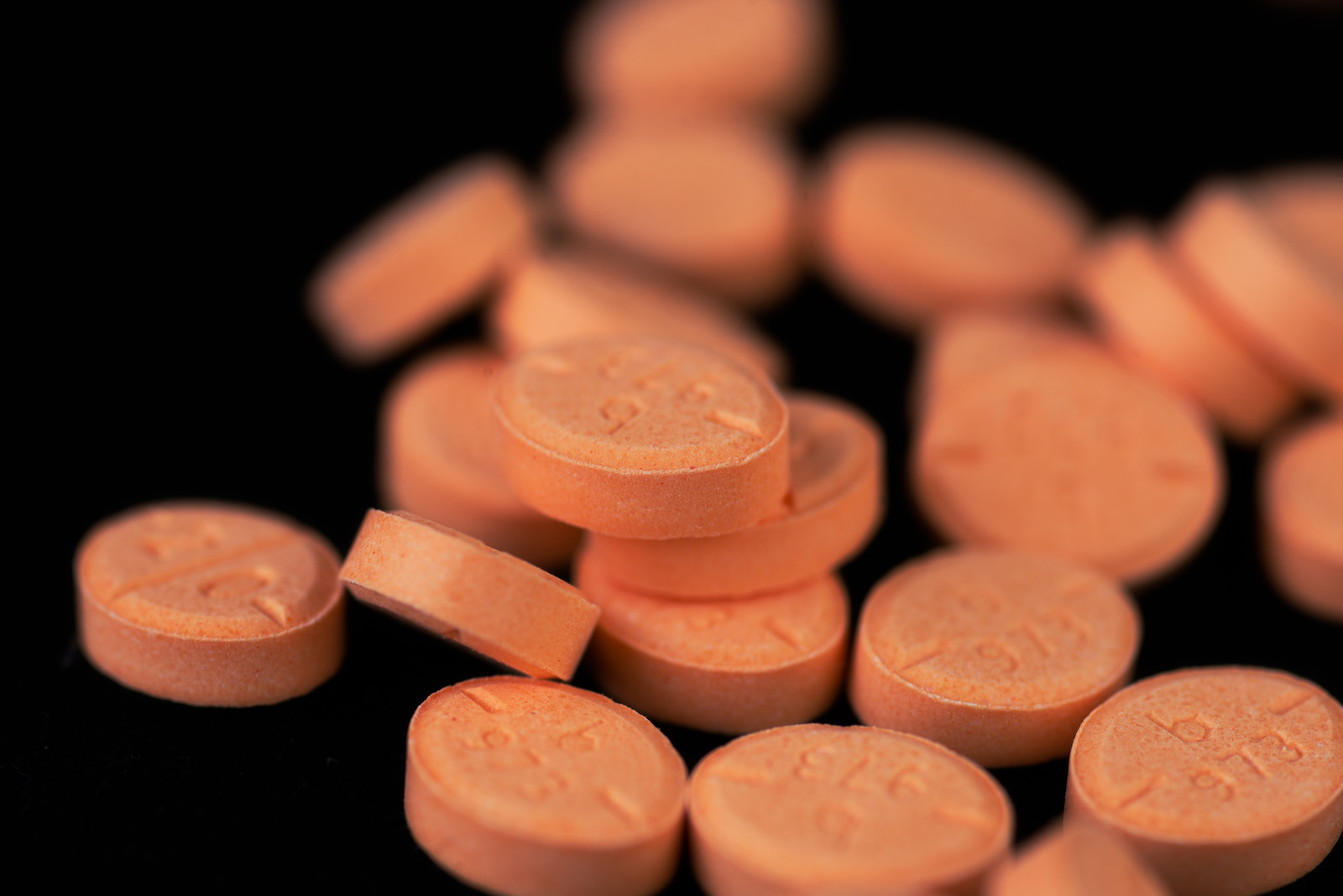
Adderall is a central nervous system (CNS) stimulant that contains a combination of amphetamine and dextroamphetamine. It’s used to treat attention deficit hyperactivity disorder (ADHD) and narcolepsy by affecting the chemicals that contribute to hyperactivity and impulse control. Depending on the form, Adderall typically comes in 5 mg, 7.5 mg, 10 mg, 12.5 mg, 15 mg, 20 mg, and 30 mg tablets or capsules.[1]
In addition to legitimate medical uses, Adderall can produce effects that may lead to misuse, including alertness, euphoria, and weight loss. With both appropriate use and misuse, Adderall can be habit-forming.
What Is Adderall?
Adderall is a prescription amphetamine combination drug that works as a CNS stimulant to treat ADHD and narcolepsy. It’s also used as an illicit drug for different purposes. According to the Substance Abuse and Mental Health Services Administration (SAMHSA), as of 2020, 1.8% of Americans aged 12 or older, or about 5.1 million people, misused prescription stimulants like Adderall in the past 12 months.[2]
In its prescription form, Adderall comes in a pill or capsule with different dosages. Illicitly, Adderall often comes in pill form but is abused by snorting, smoking, or dissolving and injecting.
What Is the Recommended Use of 15 mg Adderall?
A 15-mg dosage of Adderall falls within the recommended range for the treatment of ADHD with Adderall IR. Typically, Adderall IR for narcolepsy has a recommended dosage of 10 mg, with an increase of 10 mg each week until the maximum dosage. Adderall XR, which is typically used for ADHD only, has a recommended dose of 20 mg.
If you’re taking Adderall, it’s crucial to speak with your doctor and get a prescription with a recommended dosage. Adderall can have potentially dangerous side effects, especially with certain medical conditions, and may interact with certain drugs. Your doctor can make an informed decision about whether this drug is safe and appropriate for you with your medical history.
Recommended Adderall Dosage
Adderall comes in instant-release (IR) and extended-release (XR) forms with different recommended dosages for ADHD and narcolepsy. One lasts longer in your system than the other, depending on the dose and other factors.
The typical adult dosage of Adderall IR for ADHD is:[3]
- 5 mg orally one to two times a day as an initial dose.
- Incremental increase of 5 mg each week until ideal dosage is reached for maintenance.
- The maximum dose is 40 mg, which is only used in rare cases.
The typical adult dose of Adderall IR for narcolepsy is:[4]
- 10 mg orally per day in divided doses.
- Incremental increase of 10 mg each week until ideal dosage is reached for maintenance.
- The maximum dose is 60 mg in divided doses.
The usual adult dose of Adderall XR for ADHD is:[5]
- 20 mg orally once daily as an initial dose.
Adderall Effects and Potential Side Effects of a 15 mg Dosage

The common side effects of Adderall may include:
- Weight loss
- Appetite loss
- Stomach pain
- Mood changes
- Nervousness
- Rapid heart rate
- Headache
- Dizziness
- Dilated pupils (if misused)
- Insomnia
- Dry mouth
Adderall can cause serious side effects, even at lower doses like 5 mg, 10 mg, or 15 mg:
- Heart trouble like chest pain, breathing difficulty, or feeling faint,
- Psychosis, including hallucinations, aggression, or paranoia,
- Circulation problems like numbness, pain, skin color changes, or unexplained wounds,
- Seizures,
- Muscle twitches,
- Vision changes
Adderall can also cause serotonin syndrome, a potentially life-threatening condition in which high levels of serotonin build up in the body. The symptoms of serotonin syndrome may include hallucinations, agitation, fever, sweating, rapid heart rate, muscle stiffness, loss of coordination, nausea, vomiting, or diarrhea.
Serotonin syndrome is a serious condition that requires immediate medical attention.
In some cases, Adderall can cause an allergic reaction, which includes symptoms like hives, difficulty breathing, and swelling of the face, lips, tongue, or throat. If this occurs, get emergency help immediately.
Be sure to speak to your doctor about any side effects you may be experiencing.
Though Adderall is generally safe when taken as prescribed, misusing it can lead to overdose with symptoms like agitation, convulsions, high or low blood pressure, nausea, hallucinations, and possible death.
An Adderall overdose is a medical emergency. If you suspect someone is overdosing, call 911 immediately.
How to Use Adderall Responsibly
While Adderall is used for legitimate medical purposes, it is also a drug of abuse. People with a history of drug or alcohol use should be cautious when using Adderall. Tell your doctor if you’ve struggled with addiction.
Responsible medication use of Adderall means taking it exactly as prescribed by your doctor. Follow the directions on the prescription label and your doctor’s instructions for how, when, and how much to take. Do not adjust your dosage amount, frequency, or duration without speaking to your doctor.
Adderall should never be taken without a prescription, and if you have a prescription, it shouldn’t be shared. Keep your Adderall in a safe location where others can’t access it. Be aware that giving away or selling your Adderall medication is illegal.
Adderall is available illicitly and often misused as a weight-loss aid, study aid, or as a drug of abuse. In addition to the risks of drug interactions, side effects, or complications from existing medical conditions, it’s possible to get “fake” Adderall from illicit sources or Adderall that’s laced with fentanyl or methamphetamine, greatly compounding the risks. These drugs look similar to Adderall and generic forms, but they are much more dangerous.
Never take Adderall that wasn’t prescribed for you and dispensed by a licensed pharmacist.
Tracking Your Adderall
You should keep track of your Adderall prescription diligently. Count your tablets or capsules when you receive your medication and track them until your next refill. It’s important to be aware if anyone is taking your medication.
Like many medications, Adderall may look different depending on the dosage, type, and brand. This is important to identify your dosage and ensure you take the proper medication and dose. Medication errors happen, and taking the wrong dosage could cause significant side effects.
Adderall IR Tablets
Adderall IR comes in pressed tablets that can vary in color and shape depending on dosage.[6] They’re available in both Adderall brand and generic forms.
- 5 mg Adderall IR is a small, circular, white pill with “AD” printed on one side and “5” printed on the other.
- 7.5 mg Adderall IR is an oval-shaped blue pill with “AD” printed on one side and “7.5” printed on the other.
- 10 mg Adderall IR is a circular blue pill with “AD” printed on one side and “10” printed on the other.
- 12.5 mg Adderall IR is a round, pink-colored pill with “AD” printed on one side and “12.5” printed on the other.
- 15 mg Adderall IR is an oval-shaped, orange pill with “AD” printed on one side and “15” printed on the other.
- 20 mg Adderall IR is a circular, orange pill with “AD” printed on one side and “20” printed on the other.
- 30 mg Adderall IR is an oval-shaped, pale orange pill with “AD” printed on one side and “30” printed on the other.
Generic Adderall has a similar look, but the “AD” imprint is replaced with “dp.” Otherwise, the dosage is printed on the opposite side.
Adderall XR Capsules
Adderall XR comes in capsules with balls or beads inside.[7] The capsule may be transparent or opaque, depending on the brand or dosage.
- 5 mg Adderall XR is a blue, clear capsule with “Adderall XR” printed on the opaque half of the pill and “5 mg” printed on the other half.
- 10 mg Adderall XR an opaque and clear capsule with “Adderall XR” printed on the opaque blue half of the pill and “10 mg” printed on the transparent blue half.
- 15 mg Adderall XR an opaque and clear capsule with “Adderall XR” printed on the opaque white half of the pill and “15 mg” printed on the transparent blue half.
- 20 mg Adderall XR an orange capsule with two opaque halves and “Adderall XR” printed on one half and “20 mg” printed on the other half.
- 25 mg Adderall XR is a white and orange capsule with two opaque halves and “Adderall XR” printed on the white half and “25 mg” printed on the orange half.
- 30 mg Adderall XR is an opaque and clear capsule with “Adderall XR” printed on the opaque orange half and “30 mg” printed on the clear half.
Generic Adderall XR has a similar color scheme, but the “Adderall XR” is replaced with the manufacturer’s name. The dosage imprint remains the same.
Adderall Abuse and Addiction
Adderall use can lead to abuse or addiction, especially if you use the drug at higher doses, more frequent doses, or for longer periods than prescribed. Adderall addiction is a stimulant use disorder in the Diagnostic and Statistical Manual of Mental Disorders, Fifth Edition (DSM-5), and includes criteria like:
- Taking Adderall for longer periods or in higher doses than intended,
- Trying to stop or reduce Adderall use without success,
- Spending a lot of time getting and using Adderall,
- Experiencing cravings,
- Continuing to use Adderall despite health or interpersonal problems,
- Experiencing withdrawal when stopping or cutting back on Adderall.
Adderall Addiction Treatment
Adderall addiction can be challenging to overcome, but help is available. Adderall addiction treatment usually begins with a medical detox, which helps you stay as safe and comfortable as possible during the withdrawal period.
Once detox is complete, inpatient or outpatient treatment programs offer individualized care and the flexibility to undergo treatment in the manner that works best for your support needs and responsibilities. While in treatment, you may have treatment sessions like individual therapy, group therapy, and behavioral therapy.
Seek Help for Adderall Abuse and Addiction
Even prescribed Adderall can lead to dependence and addiction. If you or a loved one is struggling with Adderall abuse or addiction, don’t wait to seek help. Taking Adderall at higher doses or for longer periods can increase the risk of dangerous effects. Speak to your doctor or seek out a treatment center as soon as possible. They’re ready to help.




